8 tools you’ll ever need to create buyer personas

All businesses sell to someone. But not all businesses know who that someone is.
We are not talking about the market. Chances are you already have an idea of the market for your product. The usual age, gender, location, and other demographics.
What I am pointing to is the individual customer that you hope to sell to.
That’s right, drilling down to the specific characteristics of the individual buyer is called a buyer persona.
What is a buyer persona?
A buyer persona is a fictional characterization of your ideal customer. The basis for this character is real research, interviews, and data about your existing pool of clients. List down the things specific to the persona’s work such as goals, tools, pain points, and budget, among others.
The more detailed you are the more you will be able to focus your content and platforms. This will result in a better alignment of resources across your organization.
You will then attract the right fit leads and customers.
Why a buyer persona is important
I cannot overemphasize how nailing down your buyer personas will focus your Inbound Marketing.
A well-defined buyer persona will influence your messages, contents, SEO, lead generation, lead scoring, inbound sales – the whole marketing-to-sales loop.
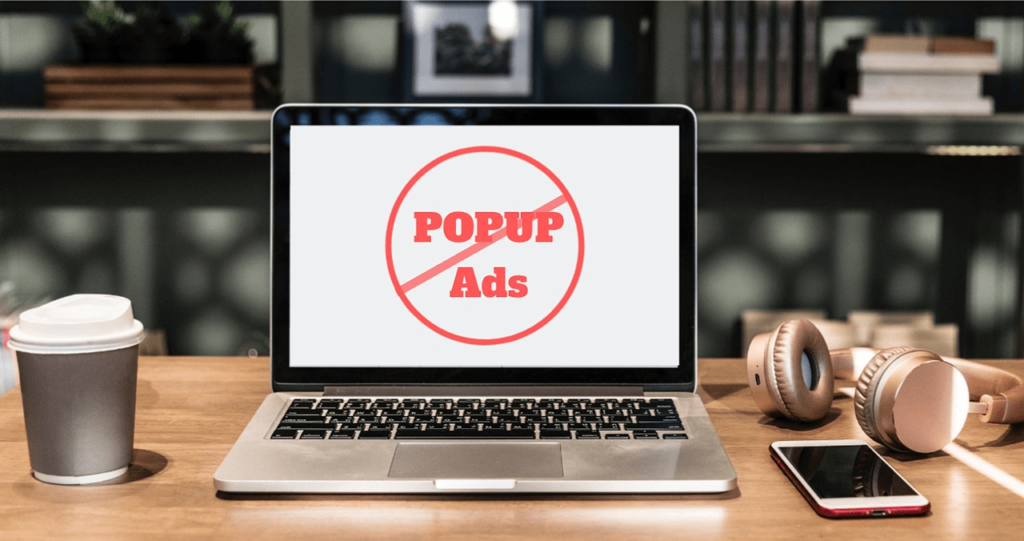
A buyer persona will allow you to break through the marketing clutter and connect with your ideal customers.
Traditional marketing is no longer effective.
People are also finding ways of tuning out other means of digital marketing. There are pop-ups and ad blockers that people install on their devices to avoid marketing.
If your marketing message does not connect with your audience in 2 seconds, they will swipe, or click away.
That is unless you connect with them right away. A well-defined and researched buyer persona will allow you to do this.
Your customer will likely engage with your content if you solve a problem that they have and tell them about your solution clearly — what, how, and how fast.
How to collect data

Here are some practical methods for gathering the information you need to develop personas:
- Review your contacts list to uncover trends like how they find and consume your content.
- Create forms on your website that capture important persona information like asking about company size on your forms.
- Talk to your sales team about the leads they’re interacting with such as behavior, goals, titles, etc.
- Interview customers and prospects.
Trust your buyer persona

A word of caution. Identifying and sticking to your buyer persona has the very real possibility of shrinking your market size.
That’s okay. Catering to everyone means a lot of bad-fit clients that end up badly for both the agency and the client.
You want to solve specific problems of specific companies. Companies where your buyer personas are employed.
We used to market ourselves as an all-in-one, one-stop-shop digital marketing agency just like our competitors. There was no differentiation.
There was a lot of bad fit client for us.
We and our competitors battled each other offering the lowest cost for the most services. And with an upstart digital agency under every rock, we fought over an ever-shrinking pie.
We decided if our market was going to shrink, it was going to be under our terms. We stuck with our buyer personas.
A lot of burden and stress were lifted soon after.
Because we stopped chasing after every request-for-pitch, we found time to do proposals that mattered to us.
Our accounts team no longer has to work their tail off for clients who pay below profit margins.
We are getting more retainer accounts rather than project clients which made business planning more realistic.
You need to target small to win big. You won’t be able to solve everyone’s problems but you can solve someone’s problems.
Conversely, people don’t buy because you can do everything. They buy because you can solve their specific problem.
Buyer persona tools you’ll ever need
Let’s keep things simple.
A buyer persona is supposed to make things easy for you. It defeats the purpose if you are going to get all hung up in creating a buyer persona.
Luckily, there are some tools that you can use to make creating a buyer persona easy peasy.
Some of them are even free. Here’s the list.
1. Make My Persona by HubSpot
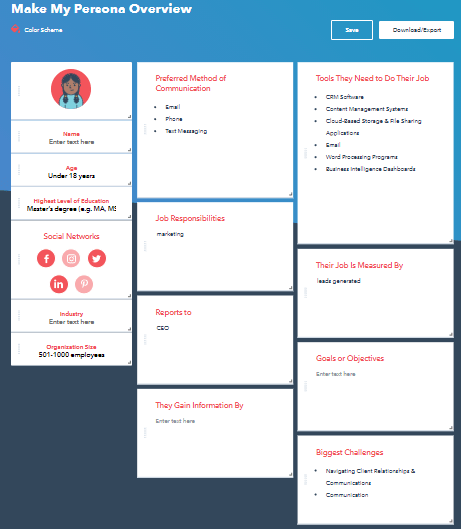
Created by leading CRM and inbound marketing advocate, HubSpot.
This online buyer persona generator leads you to a step-by-step process. You just fill in the drop-down boxes with the appropriate answer.
Did we mention that it is free?
Yup, you can use it to create various buyer personas for your business.
This is especially useful for HubSpot CRM users because the generator integrates with HubSpot. You will then be able to run emails and ad campaigns based on your buyer personas.
2. Buyer Persona Template by Designrr

This is not a generator but rather a free template of what data to capture and create into a composite of your buyer persona.
Aside from the usual demographics data, the template has sections on goals, pain points, obstacles, failed solutions, and other helpful information so that you can create a detailed character of your ideal customer.
3. Buyer persona spring
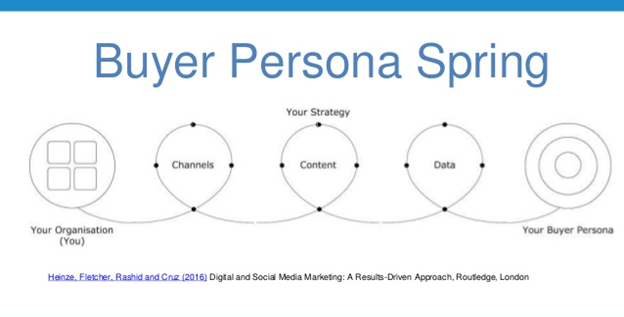
This is a very useful model for how to connect your organization’s goal to your buyer persona.
Created by professors and authors Aleksej Heinze, Gordon Fletcher, Tahir Rashid, and Ana Cruz. It has three distinct loops that form a spring. These loops have four points, at which you plan, act, observe, and reflect.
With the company goal on one end and buyer persona on the other, loops in between represent the:
- Content: What kinds of content will speak to your buyer persona?
- Channels: What social channels does your buyer persona use most?
- Data: Good data allows you to monitor your efforts, report on your success, and revise your strategy as needed.
4. Xtensio
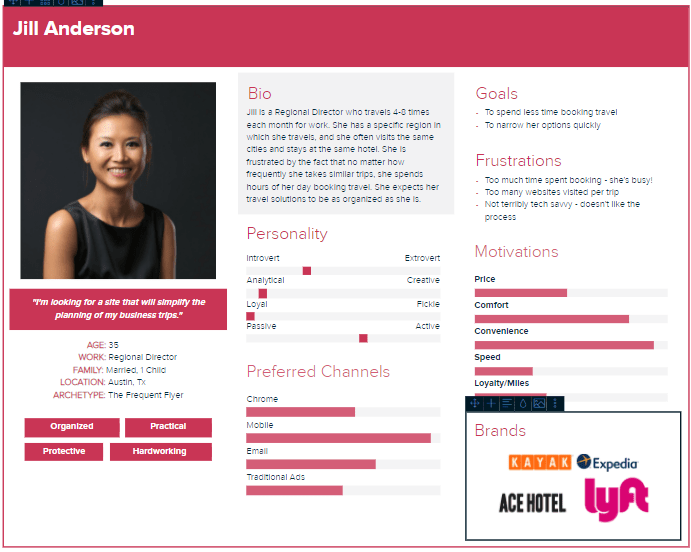
Xtensio is another great buyer persona generator that most C-level executives will like.
The render is nice, clean, and clear.
Users have the option to use their own style guide. You can customize the fonts and color schemes. There is a multi-user feature where access can be shared for team collaboration on the cloud.
Any changes sync to user devices.
5. Persona Topic Matrix by Inflow
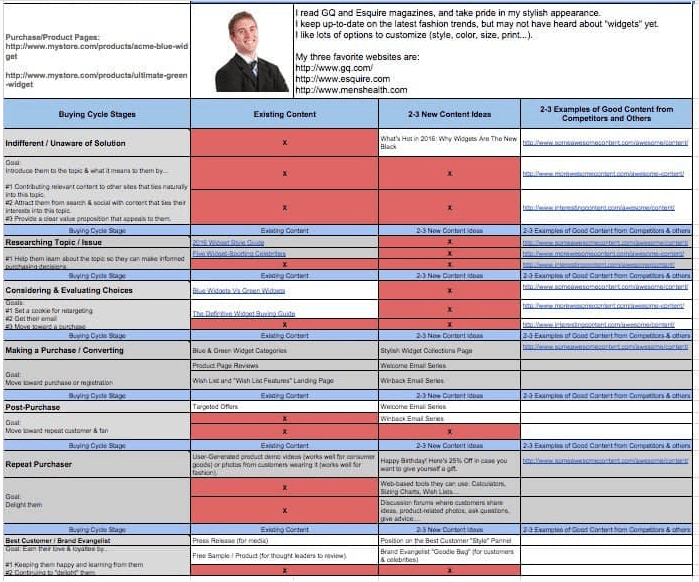
http://www.goinflow.com/persona-topic-matrix/
Unlike the other tools in this list, this one primarily concerns itself with identifying gaps in content that should be developed to engage the buyer persona.
A content gap analysis is what Inflow describes in this template. The idea is to create the right content to present to the right persons at the right time of their buying cycle.
The matrix will force users to be disciplined and exhaust ideas that will connect with their buyer personas.
6. Userforge
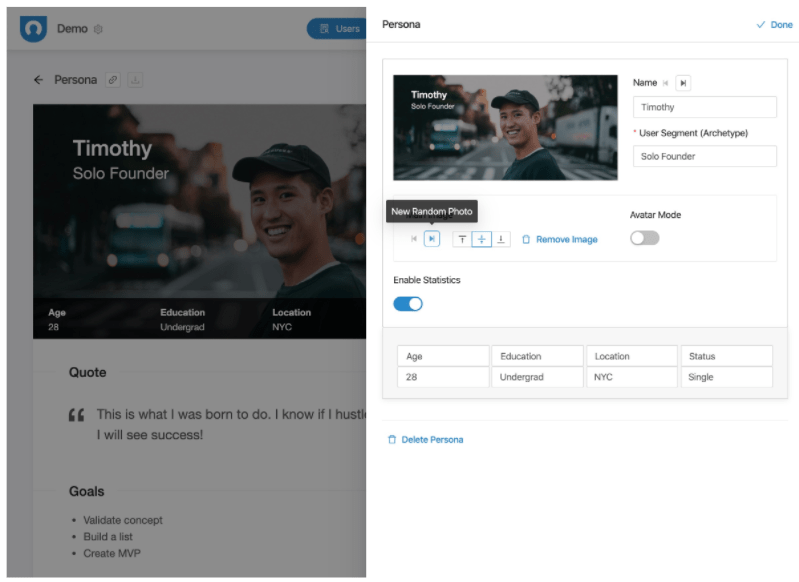
This one is a paid, subscription-based persona generator that starts at US$29 per month. You get 5 users and 20 personas.
There is a demo version that you can try online but the customization is very limited. It’s supposed to help create the UX that fits the buyer persona that you are targeting.
With this in mind, Userforge applications would be for the development of mobile apps, games, software, and other interfaces where an intuitive approach to user intent is helpful.
7. UpCloseAndPersona
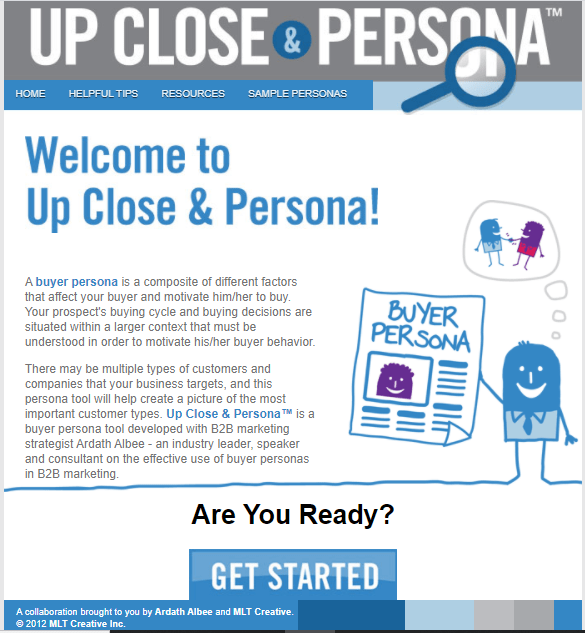
This is a buyer persona generator that is created for B2B companies.
Its buyer persona profile is divided into the company definition, problem/solution, and buyer definition.
The company definition deals with information about the company such as revenue, employees, decision-makers, market share, and competitors.
The problems and solutions sections list the pain points of the company, what have they tried doing about it, and what will happen if not resolved.
The buyer definition defines the person around the tasks, issues, and challenges surrounding their position. Its a free tool in exchange for your email and other information.
8. Buyer Persona Institute
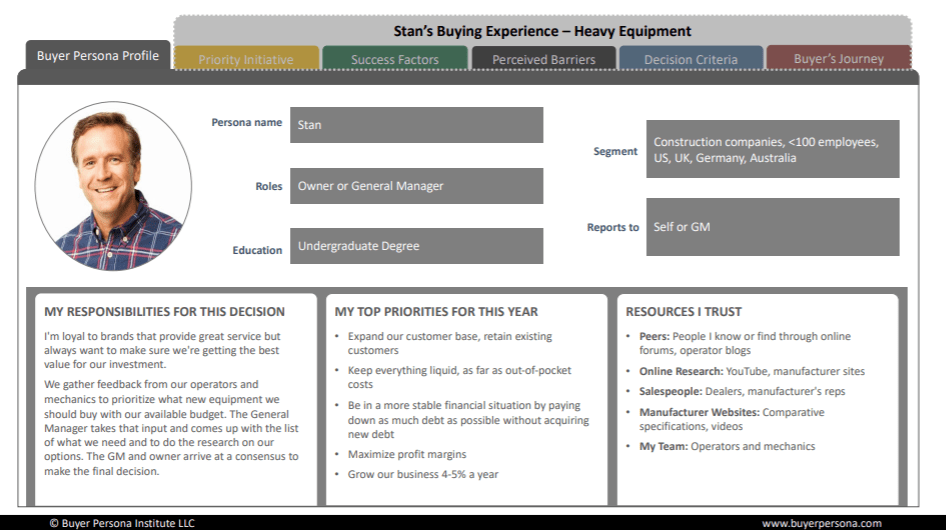
Unlike the tools we mentioned before, this one is neither a template nor a buyer persona generator.
It is a research company that specializes in segmenting the buyer persona of its clients. Why do it when you can hire someone, right?
Aside from buyer persona research, they also offer workshops such as persona activations, audience alignment plus action, and insider insights sales training.
These workshops are supposed to help their clients know what to do with their buyer persona.
A process that some companies fumble. You need to talk to their persona expert by exchanging your email to get a quote.
Conclusion
There are two things that make a buyer persona very helpful for companies that use them.
First, it is only as effective as the information that you put into it. Avoid second-guessing information about your ideal customer.
You have to reach out to your salespeople and make them buy into the process.
You also have to connect with your customers and find out what their daily life at the office is all about.
Second, what you do with your buyer persona will pave the way for a clearer purpose-driven business organization.
A buyer persona should not only touch the marketing people but also the customer services team, the sales teams, the finance team, all the decision-makers, and the gatekeepers, from top to bottom.
The whole company should be aligned, from operations to administration, towards attracting, engaging, and delighting your target buyer personas.
This is something that you need to do now.
